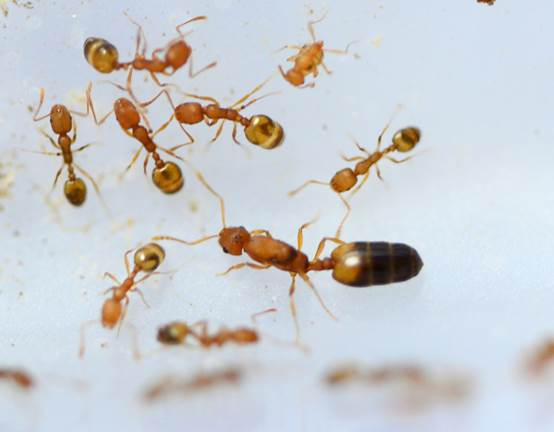Recently, scientists unraveled the core gene regulatory network determining the reproductive division of labor in ants based on comparative transcriptomics study across diverse ant species from 3 different subfamily and 5 different genera.
Ant colony consists of one or more egg-laying queens, a large number of sterile workers and some winged sexual males and gynes (unmated queens). The reproductive division of labor in ants’ queen and worker is analogous to the differentiation of germ line and somatic line in a multicellular organism. Therefore, an ant colony is also considered as a superorganism. Queens and workers are female siblings descending from the same pair of parents and share the same genome type. However, they have developed into distinct castes with different morphology, physiology and behavior, so queens dominate in reproduction while workers permanently lost the ability to reproduce.
Caste system of ants originated once from the common ancestor of all ant species 150 million years ago. It is expected that ancestral gene regulatory networks responsible for caste determination have been maintained in all ant species. However, these ancestral networks responsible for caste differentiation are also selected to adapt to various environments and reconfigured in diverse ant lineages as new species arise during evolutionary course. Therefore, the expression bias and network relationship of genes may be disguised in extant ant species, which produces a challenge for searching for the ancestral gene regulatory networks.
To disclose the hidden ancestral gene regulatory network for caste differentiation, researchers have sequenced and compared brain transcriptomes of queens and workers of representative ant species that are from 3 subfamily 5 genera along ant phylogeny tree. The ant species include Acromyrmex echinatior, Monomorium pharaonis, Linepithema humile, Solenopsis invicta and Lasius niger. The five species of ants all have fixed reproductive castes.
Through comparative analysis combining gene orthologs of all five species and normalization of lineage specific changes, a core set of 42 genes which are of same direction of caste bias and similar extent of the bias across five species were identified. In other two species of ants (Ooceraea biroi and Dinoponera quadriceps) which have lost caste system during evolution, these genes still exist whereas their regulatory network is disrupted. Thus, the 42 genes reconstruct an ancestral gene regulatory network responsible for reproductive caste determination while not involved in reproductive plasticity regulation in caste-less ants. Further analysis discovered that in honey bees, though some of the genes show caste differences, they bias towards opposite caste. The observation indicates that the caste system in ants and honey bees has independent origins and evolves along convergent trajectories.
This core set of genes provides the entry point for dissecting molecular mechanisms underlying caste determination. In addition, the study demonstrates a new paradigm for comparative transcriptomics studies across diversified species.

Monomorium pharaonis (Image By GAO Qionghua)
(By LIU Weiwei; Editor: HE Linxi)
Contact:
HE Linxi
helinxi@mail.kiz.ac.cn
